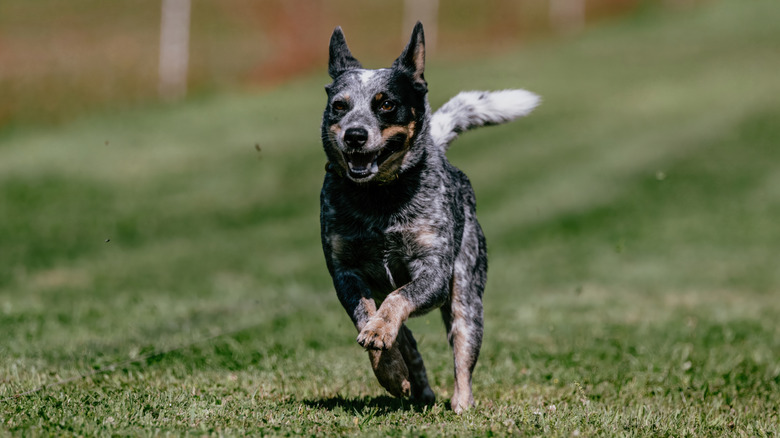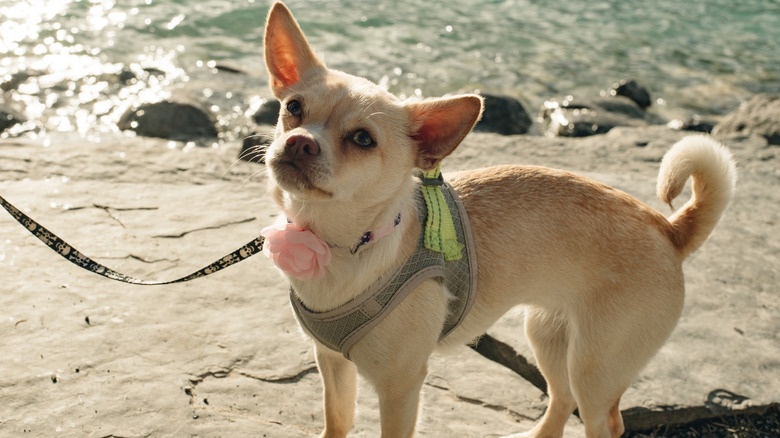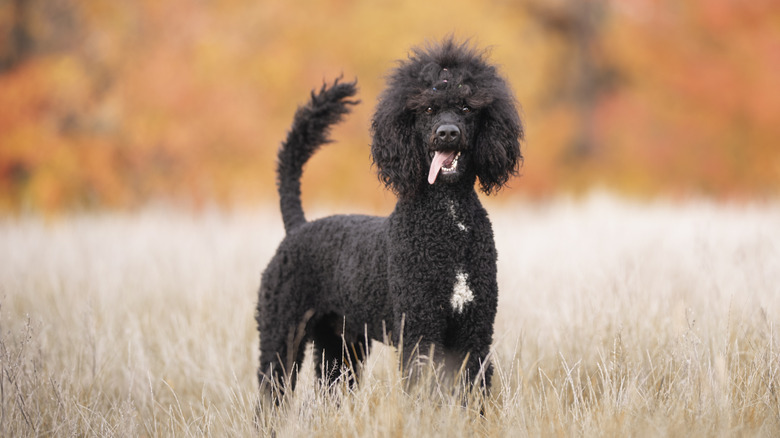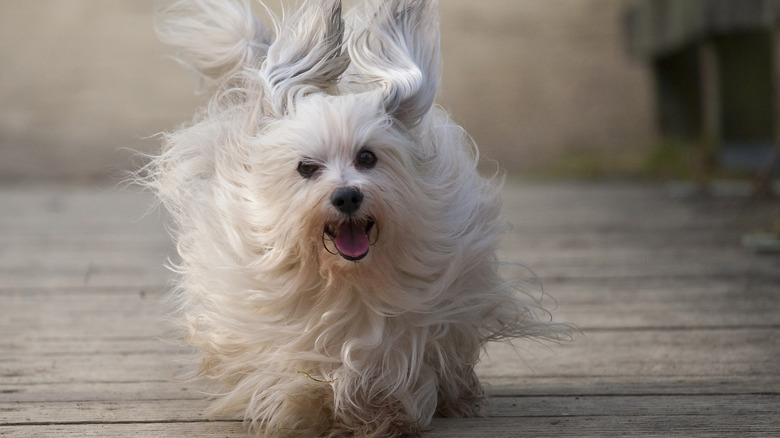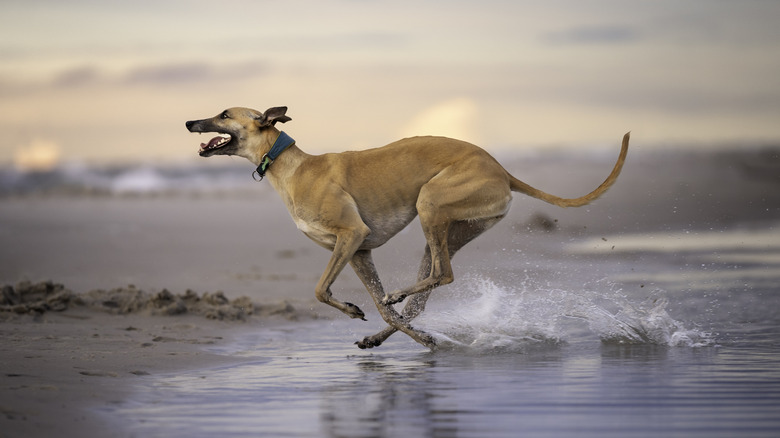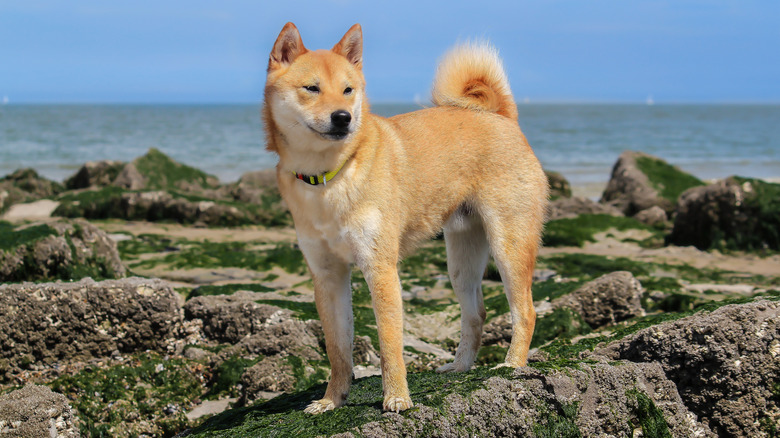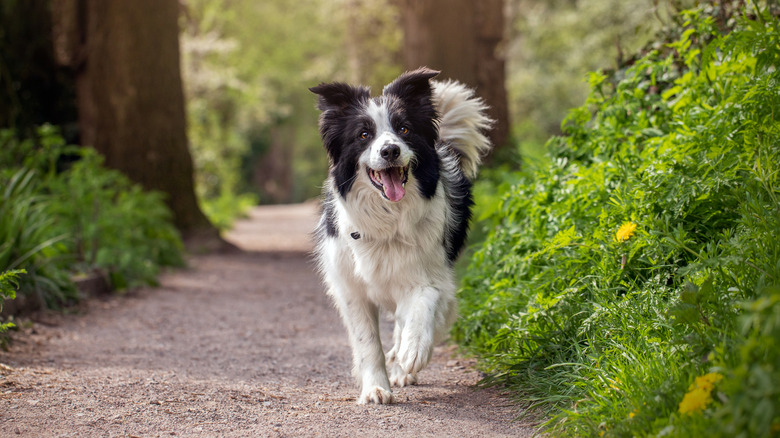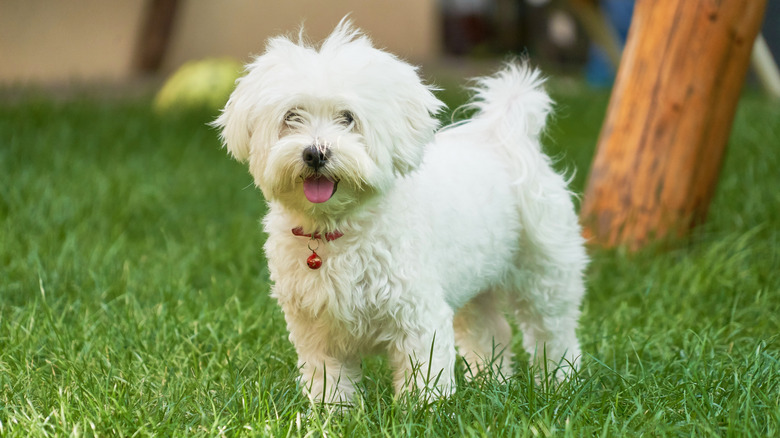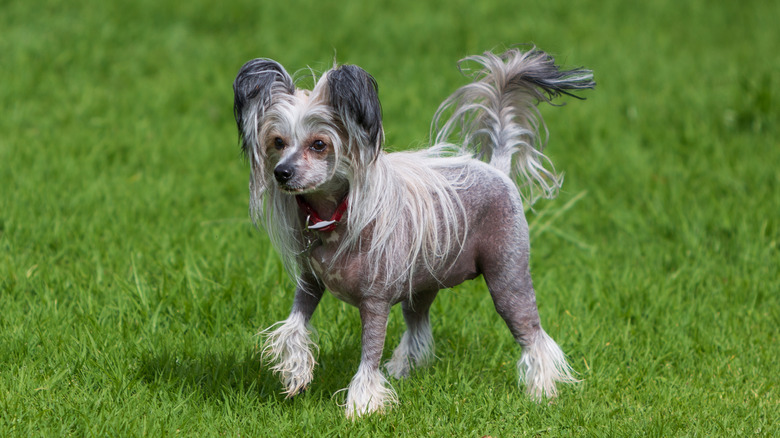12 Healthiest Dog Breeds Least Likely To Run Up Vet Costs
Welcoming a dog into your family is a profound and jubilant moment, however, it's not without its costs. Beyond the adoption fees and up-front investment for supplies, caring for a pet often comes with unexpected expenses over the duration of their life. Per Zebra, the average cost of a routine vet visit ranges from $50 to $250 in the U.S., with the average dog owner spending between $700 and $1500 annually.
Making choices that support a pooch's longevity, including setting them up with a proper diet and regular exercise, can go a long way towards avoiding pricy vet bills you can't afford. Yet, despite your best efforts, a dog's breed can significantly affect their personality and potential health issues. If you've identified physical well-being and keeping costs down as key factors in your search for a pup, certain breeds merit a closer look.
All of the dog breeds listed below are considered healthy. However, every pet comes with unique challenges, and there is never a guarantee that your furry friends will not develop expensive illnesses or conditions. You can't fully account for genetics and environmental issues when it comes to a dog's health. There is no "wonder pet" that will never get ill, and all canines face the chance of both common and rare problems arising. This uncertainty is important to consider when picking your pup, as excellent health is never assured.
1. Australian cattle dog (blue or red heeler)
A hardworking pooch from the outback, the Australian cattle dog (a.k.a. blue or red heeler depending on their coat) is a mix of several other breeds, including the wild dingo. This is a high-energy and muscular breed that has become beloved for its herding ability, protection, and companionship. It's also known as one of the most obedient dog breeds. For a happy and long life, an Australian cattle dog needs an active lifestyle and an assigned task to keep it stimulated and exercised.
A proper feeding regimen will help this canine shine, as those who work hard or participate in endurance shows may need a higher protein diet, and their meal sizes can fluctuate depending on their energy output. Starting on supplements can also ensure their joints stay healthy. If you can keep pace with this doggo's lifestyle, you will find a healthy partner who is less likely to have you paying out at the vet.
The blue heeler boasts an impressive lifespan for a medium-sized dog of 12 to 16 years, with the oldest known member of the breed being Bluey from Australia, who lived to be 29 years and 5 months old. Blindness and deafness are possibilities with the American cattle dog, but these conditions are manageable, and the costs of an eye ($50–$150) or ear exam ($50-$75) at the vet likely won't bust your budget; though medicine and other tests could inflate those expenses. Orthopedic issues, like hip dysplasia, will be the biggest concern for a pet parent, as a total hip replacement can cost upwards of $7,000 per hip.
2. Chihuahua
The Chihuahua, a mighty little warrior, has long been a favorite thanks to its apartment-friendly size and boisterous personality. The oldest known living Chihuahua is Spike, who was around 25 at the end of 2024. While Chihuahuas typically live between 14 and 16 years, they come with many possible surprises regarding health problems. Notable costly conditions include patellar luxation, trachea collapse, heart disease, hydrocephalus, legg-calve-perthes disease, and low blood sugar, per PetMD. Issues with the heart can rack up fees due to vet visits, tests, and surgeries; mitral valve disease, for example, can cost upwards of $50,000 when operated on.
Nevertheless, the chihuahua is still a healthy breed despite potential issues. Taking the time to ensure they get proper exercise, even if they're an indoor dog in a rented space, can help prolong their lifespan. Meanwhile, taking care of their teeth from a young age will help minimize the cost of orthodontic issues later in life.
3. Beagle
A long history as a hunting dog makes the beagle a pooch led by its nose. While it maintains that natural curiosity, the beagle has settled into the role of beloved family pet thanks to its affectionate nature. These hounds love to eat, so avoid free feeding in favor of a moderate diet to ensure health problems don't arise from obesity. Additionally, monitoring their weight can help prevent joint problems and having to pay for hip surgery. Their adorable floppy ears should also be cleaned regularly to prevent infections.
Beagles are more prone to seizure than other breeds, with care costs that can vary depending on severity and treatment. Cherry eye, which is the prolapse of the third eyelid, is not an uncommon condition with beagles. The use of artificial tears daily can help the condition abate, but in some cases, minor corrective surgery will be required. The price range will depend on the best method decided on by your veterinarian and your area, but you can expect to pay between $300 and $2,500 per eye. Outside of these ailments, beagles are considered a healthy breed, with a lifespan between 10 and 15 years. One beagle called Butch lived to be 28-years-old.
4. Poodle
The poodle can be a star on the show floor or the ideal companion for a busy household. Poodles come in three sizes: standard, miniature, and toy. Each variation has its own potential health issues, but we will focus on the standard poodle. These gentle giants require a fair amount of exercise to stay content and can benefit from obedience training to foster a honed sense of purpose. Because of their high energy levels, you may need to balance their diet depending on how much exercise they get. Poodles are also prone to dermatitis and allergies, so regular bathing and awareness of allergy triggers can help avoid future expenses.
Despite these health issues, a standard poodle has a life expectancy of between 12 and 15 years. Poodles are considered a hearty breed, yet the larger size makes them susceptible to bloat, which can be life-threatening. An emergency gastropexy can cost between $2,000 and $7,500 (or more). Poodles are also one breed prone to Von Willebrand's disease (blood clotting), and ongoing treatment can cost between $500 to $1,000 per session. While the condition can be prevalent in certain breeds at a higher rate, many are carriers without showing symptoms, and a reputable breeder can test for Von Willebrand's disease in advance.
5. Siberian husky
Siberian huskies were bred to withstand cold temperatures and make long treks. They had to be sturdy and healthy dogs for such an important and arduous task. Huskies have an average lifespan between 12 and 14 years. However, they are prone to eye issues, so you should take your husky for annual check-ups to ensure proper corneal care and prevent high vet costs. Regular check-ups can range between $40 to $90 to meet with the vet, but for issues like cataracts, you could expect to pay between $3,000 and $ 4,200 before needed testing, which could run over $900. Hip dysplasia (upwards of $7,000 per hip for surgery) is also a potential problem with larger breeds. Thyroid problems (hypothyroidism) can lead to further issues with weight, ears, coat, and energy levels but are often treatable with proper diet and medication. A lifetime supply of synthetic thyroid hormone levothyroxine medication is minimal (8 to 25 dollars per prescription refill) compared to the cost of surgery.
Despite its predisposition to these issues, the modern husky can be a beloved family pet or great for an active single or couple. Exercise and mental stimulation are critical for this breed to feel fully content and avoid destructive behavior. Socializing at a young age is also essential if you want your husky to play safely with other dogs at the park. A healthy and balanced diet that matches their lifestyle will help with this fluffy breed's longevity.
6. Havanese
The fluffiest of companions, the Havanese is an intelligent toy breed that makes for a trusty and loving companion for any family. These dogs are known to shadow their owners wherever they go, so a constant companion will help keep this pooch happy and avoid separation anxiety. Like other toy breeds, dental issues are not uncommon as they age, so investing in care and prevention throughout their life is essential and can help save costs. Given the regal canine's glorious locks of hair, consider food high in omega-3 or a supplement to help keep a Havanese shiny and maintain a healthy coat.
Havanese have an impressive lifespan of 14 to 16 years; while the breed has no record-breakers, it remains on the high end of longevity. Like the other little warriors on this list, the Havanese can be prone to patellar luxation (slipping of the kneecap), which can cost between $1,000 and $5,000 for surgery per knee. Legg-Calvé-Perthes Disease (a process where the femur breaks down at the socket) can occur in puppies under 18 months of age, and surgery can range between $300 to $5,000. This debilitating condition is rare but can surprise an unexpected pet parent.
7. Greyhound
Known best as the fastest breed in the world and one of the few to hunt by sight, the greyhound has long been respected for its speed and athletic prowess. The quick pooch also has an affectionate side, so as long as a family can provide ample exercise and mental stimulation, they also make for an ideal pet. Of course, with a high-energy lifestyle, a high-protein diet is essential in keeping them healthy. Notoriously independent and with a high prey drive, greyhounds need supervision around other animals, and leashing them while outside is ideal so they don't run off after prey and end up lost or injured. The Coalition for the Protection of Greyhounds notes that Greyhounds with a racing history may be prone to other issues because of possible mistreatment.
The greyhound boasts a life span ranging between 10 and 13 years, with one celebrity pooch, Genie, making it to her 20th birthday before passing. As a bigger breed, the greyhound is susceptible to the usual suspects, including hip and gastric issues (including bloat). Greyhounds have also been shown to have unique metabolism (Pharmacogenomics of poor drug metabolism in Greyhounds), which can lead to issues administering anesthesia. Anesthesia for dogs runs from $90 up to $1,000, but the problem may be complicated with a greyhound. Any surgeries can come with unexpected costs as the Greyhound is susceptible to postoperative bleeding (blood clotting). This condition can occur spontaneously or one to two days after minor trauma or surgery; treatment can cost between $500 to $4,000.
8. Shiba inu
The popularity of the Shiba Inu has risen alongside interest in Japanese culture, with many adorable dogs spilling into manga and anime. Yet these adorable doggos are not just favored because of memes and pop culture; they are an inquisitive and expressive breed ideal for a family of any size. These are high-energy and intelligent pups that need exercise, and the Shibu's vocal and independent nature is better suited for an experienced owner who can properly train and focus their energy. Prone to allergies, you will want to keep their coat and ears clean to help avoid trips to the vet for infections.
Shiba inu life expectancy is between 13 and 16 years. One dog named Pusuke is the oldest on record, making it to 25 years old. Kabosu, the dog behind countless memes and the face of the DOGE coin, also had a long life, passing at 18. Besides common issues with smaller breeds like dental and patella luxation, one primary concern with a Shiba is anxiety. A Shiba inu can be very prone to separation anxiety, and if you are not working from home or have someone with you all the time, this can cause destructive behavior and stress. While CBD oil use has become more popular, it is still in its infancy of long-term studies on the effects; you should discuss the anxiety reducer with your vet first (via PetMD).
9. Border collie
Border collies are known for their big personalities and high energy, making them beloved pets for families and active households. For a medium-to-large-breed, they boat an impressive lifespan of 12 to 15 years. The oldest living border collie was an Irish-based dog named Skippy, who passed at the age of 27. As a bigger breed, border collies are susceptible to hip dysplasia and epilepsy.
The border collie also has several unique health issues that can appear at birth or within the 15- to 20-month range. Thankfully, all these can be tested for or are noticeable in puppies; allowing owners to plan accordingly. Moreover, seeking a reputable breeder can help you avoid the emotional strain and financial burden. Collies are prone to multidrug resistance mutation, which means they can't use several common veterinary medicines. The test for this condition is around $70, but taking it can save you money on pharmaceutical costs for your collie in the future.
Recognized as the most intelligent dog breed, the energetic border collie needs mental stimulation as much as it does physical activity to stay content. A balanced diet high in protein and omega-3 will help fuel their lifestyle and keep their coat shiny. This dog breed's double coat means that you should not shave them and brush your pooch at least three times per week to avoid matting.
10. Bichon frise
The adorable curly fluff known as the bichon frise has become a favorite for apartment living due to its small stature and moderate energy requirements. Still, these clever little doggos need stimulation to stay happy; this breed loves its toys. Teeth cleaning is essential with this small breed to help avoid issues later in life. The bichon frise has a double coat of a thick inner layer and a curly outer layer, and to ensure a healthy coat free of mats, it should be taken to a professional groomer every four weeks. Ears should also be cleaned regularly with a vet-approved wash, as the breed is prone to infections.
The bichon fries have a life expectancy of 14 to 15 years; the oldest on record is Freddie from Australia, who passed at 20. The bichon frise can have eye issues, including cataracts and corneal dystrophy. Corneal dystrophy, a clouding of the eyes that can limit vision, can occur between two and eight years of age. There are three types of corneal dystrophy, with advanced epithelial or endothelial potentially leading to ulceration requiring further treatment. Surgery ranges drastically based on the size of the ulcer, between $200 to $2,000. A bichon frise may develop diabetes later in life. Diabetes can be manageable with proper diet and medication; the cost of insulin for dogs ranges between $30 to $300 per month, and additional vet visits are important to monitor progress.
11. Chinese crested
The Chinese crested has become somewhat infamous for its appearance, with the breed often garnering first place in the "world's ugliest dog" competition. Yet, some have found a fondness for this curious-looking pooch, with their unique personalities matching their appearance. A Chinese crested should always be monitored by its owner when playing with other dogs or children to avoid rough play for this petite pooch. Possible dental issues with smaller breeds also mean that keeping their teeth clean will help save costs as they get into their twilight years.
Chinese crested dogs have a life expectancy of around 15 to 16 years, but there have been many cases of this breed living to be as old as 18. The Chinese crested is prone to eye issues, including primary lens luxation, which may require surgery to correct; a lensectomy can range drastically between $500 and $3,000 per eye. As a (mostly) hairless breed, the Chinese crested's skin needs extra attention with sunscreen or covering up, depending on the season. Skin cancer from sun exposure can rack up costs quickly, depending on the severity and treatment. The quirky pooch can suffer from orthopedic issues that most small breeds face, including patellar luxation and Legg-Calvé-Perthes disease.
12. Old English sheepdog
If saving on vet fees is a significant concern, it's advised to avoid large dog breeds, as any costs incurred will be higher, given their size, leading to higher boarding costs and increased drug dosage. However, if you want a large dog, the old English sheepdog is considered generally healthy despite the various conditions it is predisposed to, including hip dysplasia, progressive retinal atrophy, hypothyroidism, cerebellar abiotrophy, deafness, and heart issues. Even with these conditions, the old English sheepdog is one of the healthiest companions out.
Weighing upwards of 100 pounds, this gentle giant needs a fair amount of exercise and stimulation to stay happy. Having a regular job will help keep them focused and active. Caring for their luxurious coats is essential to avoid health issues like skin irritation. Prioritize cleaning around the eyes and ears to prevent infections. Take these steps and you can expect your Old English sheepdog to live between 10 and 12 years.

